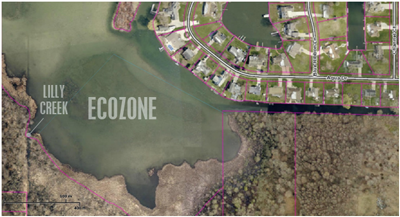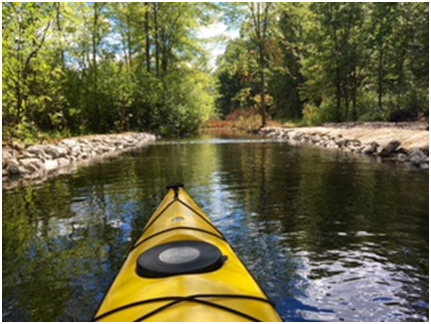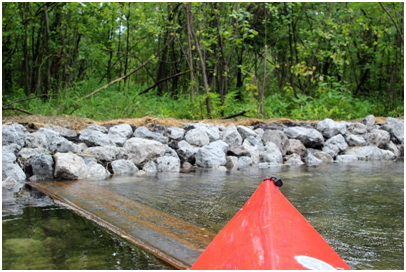Weir Project
 Simonton Lake is a spring-fed lake, there are no rivers or streams that flow in to the lake. But, there is a creek that empties the lake. Lilly Creek, also known as Lilly Ditch and Osolo Ditch can be found near the ecozone on the southeast border of the small basin. From there the creek flows southwards and empties into the St. Joe River in Elkhart. During droughts the level of the lake drops to a dangerous level as water from the lake flows out through Lilly Creek.
Simonton Lake is a spring-fed lake, there are no rivers or streams that flow in to the lake. But, there is a creek that empties the lake. Lilly Creek, also known as Lilly Ditch and Osolo Ditch can be found near the ecozone on the southeast border of the small basin. From there the creek flows southwards and empties into the St. Joe River in Elkhart. During droughts the level of the lake drops to a dangerous level as water from the lake flows out through Lilly Creek.
What is a Weir?
A weir is a barrier across a river designed to alter its flow characteristics. In most cases, weirs take the form of obstructions smaller than most conventional dams, pooling water behind them while also allowing it to flow steadily over their tops. Weirs are commonly used to alter the flow of rivers to prevent flooding, measure discharge, and help render rivers navigable. In the case of the Lilly Creek Weir, the purpose would be to protect the level of water in the lake. When the water is high, the excess water would flow over the top of the weir. In times of drought when the water is low, the weir would prevent water from leaving the lake until the level of the lake reaches the legal lake level.
History of the Project
On August 2, 1996 the Elkhart County Drainage Board applied for a permit to dredge
the Osolo Township Ditch known also as Lily Creek from Simonton Lake to just north of Miller Street.
Miller Street is located just north of the Greenleaf Estates and Eastlake Estates subdivisions in the City of Elkhart. This was the beginning of a twenty year-long effort to place a weir at the creek to protect the level of water at Simonton Lake.
The initial plan that was proposed was that the Elkhart County Drainage Board would construct a weir in the ditch to allow dredging of the ditch no closer than ¾ mile from the lake. This would prevent water rushing out of the lake as the ditch was dredged. The weir was to be constructed to a certain elevation. But, the level prescribed was 10” lower than the existing water level of the lake. So, it was decided to investigate changing the legal lake level number to represent the water level using the last 10 year averages.
The Drainage Board agreed to postpone their dredging project until lake residents went
through the level change process. On May 5th, 2006 Judge George Biddlecome of Elkhart Superior Court #3 ordered that the petition to establish the new lake level be granted. But, then a process began on who would pay for the construction of the weir.
Indiana State Statutes dictated that the State of Indiana would pay 50%, the County would pay 25% and the lake residents would pay 25%. After several meetings the County looked into the possibility of County funds being used to pay the lake residents 25% share.
Finally, on February 5th 2016 Elkhart County Superior Court Judge Cataldo ruled that the Elkhart County Drainage Board would pay 50% of the construction costs not to exceed the amount of $78,478.00.
The Indiana DNR per state statute would pay 50% or not to exceed the amount of $78.478.
If the project exceeded the maximum amount of $156,956.00 the County would pay the additional money.
Elkhart County Surveyor, Blake Doriot, set the bidding process for spring or early
Summer of 2016 and with construction beginning as early as July 1, 2016 and a completion date of March 31, 2017.
In May 2016 the Drainage Board opened the sealed bids for construction, only to discover that there was only one bid and that bid was for more than twice the estimate. This bid fell far outside the range of the current funding capacity. The reason for the extreme difference in the bid and the estimate was due to the unusually wet spring and the lake level trending unusually high. The weir construction site was virtually inaccessible without employing costly construction techniques. All equipment and materials would have to be transported through an extremely marshy area.
It was determined by the board, since the summer weather forecast was for an unusually hot and dry summer, they would wait until July and rebid the contract. The County Surveyor also suggested that the county might attempt to clear some of the vegetation in Lilly Creek that is restricting the flow in order to help lower the lake level. As predicted the summer of 2016 was hot and dry and the lake level did fall by a few inches.
On July 12, 2016 the Elkhart County Drainage Board met and approved a bid for the weir. Work began in early August 2016.
To date the weir has worked as we had planned. It keeps water from draining from the lake in times of drought but allows water above the legal lake level to drain from the lake in wet weather. In 2019 it appeared that the creek was not draining as well. The County Drainage Board voted to proceed with permits to clean out the vegetation that was slowing down the flow of water.
Lily Creek Weir completed Fall 2016!

Approach to the weir down the newly dredged Lilly Creek

The top of the weir as it breaks the surface of the water.